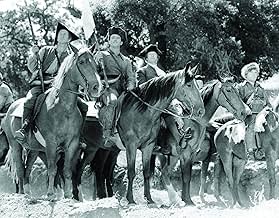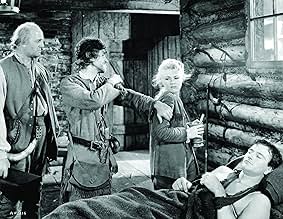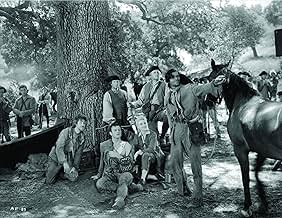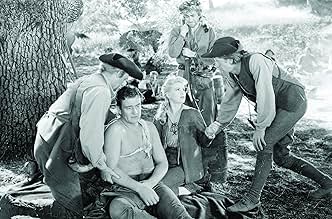Aggiungi una trama nella tua linguaIn 1759, in Pennsylvania's Allegheny Valley, local settlers and Indian fighters try to persuade the British authorities to ban the trading of alcohol and arms with the marauding Indians.In 1759, in Pennsylvania's Allegheny Valley, local settlers and Indian fighters try to persuade the British authorities to ban the trading of alcohol and arms with the marauding Indians.In 1759, in Pennsylvania's Allegheny Valley, local settlers and Indian fighters try to persuade the British authorities to ban the trading of alcohol and arms with the marauding Indians.
- Regia
- Sceneggiatura
- Star
- One of Jim's Black Boys
- (non citato nei titoli originali)
- Settler at McDowell's Mill
- (non citato nei titoli originali)
Recensioni in evidenza
This is an entertaining film with noisy action, battles, romance and comedy . After the hit of Stagecoach, RKO hurriedly put their new hero cowboy , The Duke John Wayne, and his partenaire Claire Trevor in another Western, but this time resulted to be a lesser effort. Pretty good man and support cast accompany the brave and stuborn protagonists. Not a bad movie, but not memorable, either, however, being entertaining enough . Wayne gives a nice acting as the frontiersman who clashes with a British commander in order to stop his injustice. His leading lady Claire Trevor provides a silly acting and overacting, at times, as the obstinate sweetheart chasing Wayne here and there. And notorious secondaries appearing, such as : George Sanders as British military commander, Brian Donlevy as the villain seller, Wilfrid Lawson, John Hamilton, Moroni Oldsen, Roger Barrat, Ian Wolfe, Eddie Quillan and a thin Chill Wills. It packs an atmospheric cinematography in black and white by Nicholas Musuraka, a bit later on, to become one of the best Film Noir cameramen as well as John Alton, John Seitz or Sol Polito. Furthermore, it delivers a thrilling and evocative musical score. The motion picture, lavishly produced by RKO/Pandro S. Berman, was regular but professionally directed by William A Seiter 1890-1964. He was a fine craftsman who diected films of all kinds of genres as drama, thriller , musical, Western, romantic comedy, such as : In person, Stowaway, Dimples, Room service, The moon's our home, Susannah of the Mounties, It is a date , Nice girl?, You were never lovelier, Lady takes a chance, Destroyer, Little giant, I will be yours, Up in the Central Park, One touch of Venus, Borderline, Make haste to live. Rating : 6/10. Decent, passable and acceptable, though very inferior to Stagecoach . Also available on horrible colorized version.
Wayne plays Jim Smith, leader of a band of settlers of southern Pennsylvania's Conococheague Valley in the years immediately following the French and Indian War. Smith & Company's efforts to deal with a crooked Indian trader (veteran Hollywood villain Brian Donlevy) are hampered by an officious, pig-headed, and not-too-bright British Army officer (veteran Hollywood stuffed shirt George Sanders). Smith also has to deal with the local tomboy (Miss Trevor) who has a deep yearning for adventure and excitement, as well as the affections of Jim Smith.
Wilfrid Lawson also appears as MacDougall, the rowdy Scotsman who loves fighting almost as much as drinking. John F. Hamilton is the eloquent but enigmatic sidekick, known as the Professor. Moroni Olsen, possessor of one of filmdom's coolest names, is the stalwart Tom Calhoon. Veteran second-string Hollywood villain Ian Wolfe is the evil trader's Evil sidekick. Also appearing in small roles are Chill Wills (another cool name) and Charles Middleton, heretofore best known as the stone-faced Fredonian prosecutor in "Duck Soup".
Interesting historical detail: in a courtroom scene, a witness is asked to "swear or affirm" that what he's about to say is the truth, the whole truth, and nothing but the truth. This should serve to remind the viewer that Pennsylvania was a Quaker Commonwealth. (Quakers don't believe in swearing, you see...)
The contrast is refreshing. Whereas Mel Gibson and his bunch of cut-throats often sound and act as if they had come straight out of THE TURNER DIARIES, John Wayne and his own band of irregulars live according to the principles of another gospel - that of law and order, western style. The film is indeed a western, in spite of the geographical and historical settings - the mountains of Western Pennsylvania, 15 years before the Boston Tea Party. More specifically, it is a glorified version of the typical B-movie western of the era, which often starred John Wayne, was often shot in exactly the same locations, and always featured the same formulaic story-line and motley collection of stock characters, such as the soft-spoken community leader, the wild mountaineer who talks and acts so funny, the tomboy love interest, who would like so much to be treated like a guy, but cannot, because she is *only* a girl, etc. The main difference, of course, is one of scale and production value : this is not a cheaply mid-length program filler, but a full-blown feature film in which enough talent and production value has been invested to sustain interest from the beginning to the end, even some 60 years later - and this in spite of a few dated scenes and some awkward moments of political incorrectedness (e.g. the questionable philosophical adage Çthe only friendly Indian is a dead IndianÈ is quoted approvingly).
The film, as suggested above, is based on the central classical theme of the western genre : the implementation of law and order on a wild and untamed country. In this case, however, the familiar story is told with a novel twist. The author of the screenplay has remembered that American law is, in fact, English law, but adapted to the peculiar circumstances of the new country. The pre-Revolutionary setting has provided him with an opportunity to oppose the two understandings of the same legal tradition - the new, American, understanding of English law represented by James Smith (John Wayne), a nation-builder and a free spirit who does not always play by the rules, but abides by the spirit of the law in his attempts to curb illegal liquor and arms trading with Indians, and the old, British, view, as represented by Captain Swanson (George Sanders) an upright, but unimaginative and incredibly obtuse military officer of a far-away Crown who does not seem to know of any other way to apply the law, but to the letter, regardless of common sense and consequences. In his own words : ÇI am a soldier, sir. They could have been carrying the murder of my own father if they had a permit for them. I would have defended them with my own life.È The point of the story is both that the clash between the Britain and America was inevitable and that they would eventually be reconciled because of their deep shared faith in the same ideals of justice - ultimately, it will be observed, it is the British General Gage who steps in to resolve the dispute between soldiers and colonials in a remarkably fair and even-handed manner.
We are very far from the exercise in quasi-racist British-bashing characteristic of THE PATRIOT! However, the two films have this in common that they fail to make their British villain credible. In the case of THE PATRIOT, this is due both to Robert RodatÕs script - all in black and white - and the acting, for Jason IsaacsÕ main asset, sad to say, seems to be his uncongenial face. George Sanders, on the other hand, is one of the greatest character actors specializing in villainy that Hollywood ever had. (Even his stints in BATMAN and THE MAN FROM U.N.C.L.E. are very much worth seeing!) He had the face - and so much more : the style (ÇRemove this barbarian from the courtroom!È - Who could have said it more contemptuously?) Unfortunately, there is little that he can do to lend genuine human substance to the cardboard unidimensional character entrusted to his art. The scriptwriter seems to have meant to depict a specimen of obdurate military stupidity (British style) closely patterned on the Captain Bligh of Charles Laughton from four years earlier (MUTINY ON THE BOUNTY, Oscar for Best Picture in 1935), but, evidently, he lacked the means of his ambitions. Sanders still makes the best of the uneven material and he has his moments, most notably the scene when, besieged in his fort with his troops, Swanson orders that the soldiers who caught napping be flogged, and yet treats kindly the one man whom he actually finds sleeping on duty.
The movie might be more properly titled San Fernando Valley Uprising since the terrain is familiar from a thousand matinée Westerns. Still, the producers popped for a bunch of extras with redcoats and also an impressive looking fort that even has realistic tree stumps indicating a cleared forest on the approaches.
To me, however, the movie's a disappointment. More importantly, the material shows why John Ford was such a master of this type of movie— that is,"winning the West" with roistering men and headstrong women, amusing drunks and slippery villains. The trouble here is that there's nothing humorous about the obnoxious drunk (Lawson), while Trevor in a padded part goes way over the top as a tomboy, but worse, she's allowed to interrupt the action just as it gets rolling.
The screenplay doesn't help either. Note that despite all the shooting and confrontations, no redcoat kills a colonist or vice-versa-- a rather strange outcome for an armed "uprising". My guess is that the pre-war year 1939 didn't want to show potential allies against the Nazis killing each other; then again, maybe American or British casualties would have complicated sorting out blame, which otherwise lies with the sneaky traders (Donlevy & Wolfe). Whatever the reason, it remains a pretty unbelievable development, given all the shooting.
On the other hand, Wayne shows potential as an outstanding leader of men, while Sanders is excellent as usual as a literate snob, this time an English officer. I did miss a strong Ward Bond-type as Wayne's buddy instead of the rather foolish professor (Hamilton). Anyway, the elements don't really gel into the kind of action movie that gets remembered. I just wish that superb story teller John Ford had gotten hold of the material first.
Lo sapevi?
- QuizFor the role of Capt. Swanson actor George Sanders replaced Sir Cedric Hardwicke due to Hardwicke's other commitments.
- BlooperThe shooting demonstration done in court was described as taking place at twenty paces. Twenty paces is equal to approximately 60 feet; the shots fired in the film were at approximately 20 feet.
- Citazioni
The Professor: Men, we've fought and won. But in winning we have lost something. In defending one law, we've come to despise all law. And if you go on like this, we'll destroy the very thing we fight for.
- Curiosità sui creditiOpening credits prologue:
This is a tale, laid in the Allegheny Mountains, of Jim Smith and his black boys, loyal subjects of His Majesty King George III - and their fight against the Delaware Indians in the year 1759.
- Versioni alternativeAlso available in a computer colorized version.
- ConnessioniReferenced in Maude: Maude Meets the Duke (1974)
- Colonne sonoreYankee Doodle
(uncredited)
Music traditional - English origin (ca. 1755)
Arranged by Anthony Collins
Sung by the men at MacDougall's tavern
Reprised by the men after the trial
Variations in the score throughout
I più visti
- How long is Allegheny Uprising?Powered by Alexa
Dettagli
Botteghino
- Budget
- 696.000 USD (previsto)
- Tempo di esecuzione
- 1h 21min(81 min)
- Colore
- Proporzioni
- 1.37 : 1




































